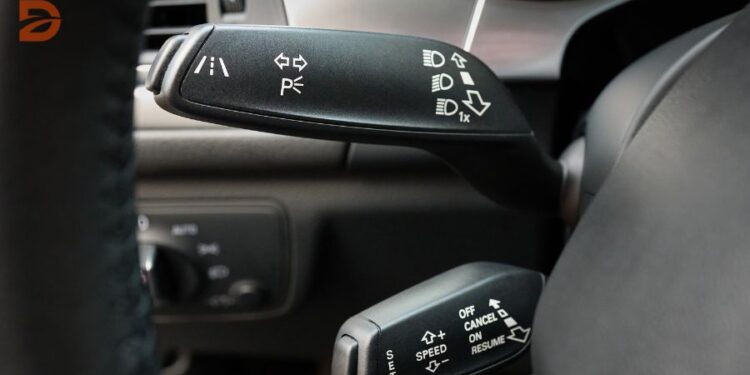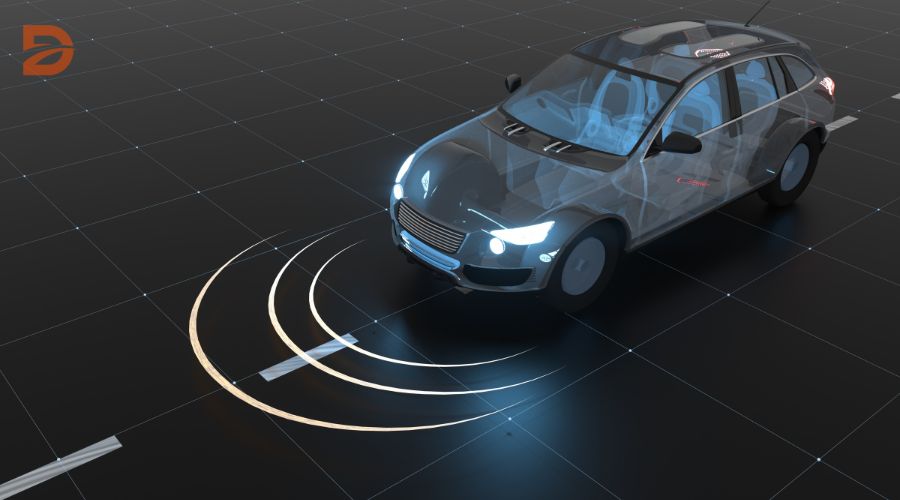As the number of fatalities on U.S. roads continues to rise, the need for advanced driver assistance technologies like lane departure warning systems has never been more crucial. These innovative features use cameras and sensors to monitor lane markings, alerting drivers when their vehicle starts to drift out of its lane unintentionally. By providing real-time feedback, lane departure warning systems can help prevent accidents and keep drivers and passengers safe on the road.
But with so many options available, which lane departure warning features should you look for in your next vehicle? From the latest SUV models to luxurious sedans, this article will explore the top-rated lane departure warning systems for 2024, highlighting the key benefits, leading automakers, and the latest advancements in this life-saving technology.
Key Takeaways
- Lane departure warning systems use cameras and sensors to detect when a vehicle drifts out of its lane, providing real-time alerts to the driver.
- These systems can help prevent accidents and enhance overall road safety, especially in preventing distraction-related incidents.
- Leading automakers like Acura, BMW, Honda, and Mercedes-Benz are equipping their vehicles with advanced lane departure warning and assistance features.
- Factors like weather conditions and road quality can impact the effectiveness of lane departure warning systems, emphasizing the need for driver attentiveness.
- Comprehensive driver assistance packages, including lane centering and blind spot monitoring, offer the highest levels of safety and protection on the road.
Understanding Lane Departure Warning Systems
Lane departure warning systems have become increasingly common in modern vehicles, playing a vital role in enhancing road safety and accident prevention. These advanced technologies use a combination of cameras, sensors, and sophisticated algorithms to monitor a vehicle’s position within its lane and provide timely warnings to the driver.
Key Components and Functionality
The core components of a lane departure warning system include forward-facing cameras that detect lane markings, radar or lidar systems that track the vehicle’s position relative to lane boundaries, and intelligent software that analyzes real-time data. When the system detects the vehicle drifting out of its lane, it can trigger various alerts, such as audible warnings, visual displays, or even slight steering or braking inputs to help keep the vehicle centered.
Types of Lane Departure Warning Systems
There are several types of lane departure warning systems available in the market, each with its own unique features and capabilities:
- Lane Departure Warning (LDW): This system simply alerts the driver when the vehicle starts to drift out of its lane, without any active intervention.
- Lane Keeping Assist (LKA): This system can provide gentle steering corrections to help guide the vehicle back into its lane if it begins to wander.
- Road Departure Mitigation (RDM): This advanced system can apply braking force to prevent the vehicle from leaving the roadway entirely, providing a last-resort safety measure.
Understanding the differences between these systems is crucial for shoppers to find the right lane departure warning technology that meets their specific needs and driving preferences.
| Feature | LDW | LKA | RDM |
|---|---|---|---|
| Warning Type | Audible, Visual | Steering Assist | Braking Intervention |
| Functionality | Alerts Driver | Nudges Vehicle Back | Prevents Road Departure |
| Effectiveness | Moderate | High | Highest |
By understanding the capabilities and differences between these lane departure warning systems, consumers can make informed decisions and choose the best option to meet their safety and driving preferences.
Benefits of Lane Departure Warning Technology
Lane departure warning systems offer a range of valuable benefits that can significantly enhance overall road safety. By alerting drivers when their vehicle begins to drift out of its lane, these advanced systems play a crucial role in preventing accidents caused by distracted, drowsy, or impaired driving. Studies have shown that lane departure warning technology can reduce the risk of single-vehicle, sideswipe, and head-on collisions by up to 55%.
Furthermore, lane departure warning systems can assist in mitigating the impact of a collision by triggering automatic braking or steering interventions in emergencies. Estimates indicate that light steering to aggressive steering lane departure prevention (LDP) systems can reduce the number of crashes by 32.7% to 37.3% and the number of seriously injured drivers by 26.1% to 31.2%. With LDP systems that possess autonomous driving characteristics, the potential impact is even greater, with a projected reduction of 51.0% in crashes and 45.9% in serious injuries.
Ultimately, the widespread adoption of advanced lane departure warning features has the potential to save thousands of lives each year by addressing one of the leading causes of automobile accidents – unintended lane departures. According to the National Highway Traffic Safety Administration (NHTSA), departure crashes accounted for only 10% of all crashes yet comprised 31% of all fatal crashes in the U.S. in 2010-2011.
Lane departure warning, vehicle safety tech
As modern automobiles continue to evolve, the integration of advanced vehicle safety technologies has become increasingly prevalent. At the forefront of this technological revolution is the lane departure warning system, a critical driver assistance feature that plays a pivotal role in enhancing road safety and accident prevention.
These cutting-edge collision avoidance systems utilize a range of sensors and cameras to constantly monitor the vehicle’s position within its lane. By detecting unintentional lane departures, the system can alert the driver, prompting them to take corrective action and prevent potentially dangerous situations.
- Studies have shown that lane departure warning systems can reduce lane departure crashes by up to 11%.
- The adoption rate of these systems in new vehicles is increasing at a remarkable pace of approximately 12% annually.
- Vehicles equipped with lane departure warnings have seen a decrease of up to 21% in single-vehicle sideswipe crashes.
As autonomous safety capabilities continue to evolve, lane departure warning systems will play an integral role in enabling the next generation of self-driving vehicles to navigate roads safely and reliably. For today’s drivers, these advanced driver-monitoring technologies provide an added layer of protection and confidence behind the wheel.
“Lane departure warning is ranked as one of the top three most desired vehicle safety technologies by consumers in various surveys, behind only automatic emergency braking and blind-spot detection.”
With the increasing integration of these innovative vehicle safety technologies, drivers and passengers can look forward to a future of enhanced road safety and greater peace of mind on the journey ahead.
Top-Rated SUVs with Advanced Lane Departure Warning
As consumer demand for cutting-edge safety features continues to grow, leading automakers are equipping their latest SUV models with state-of-the-art lane departure warning systems. Two standout examples that showcase the capabilities of this technology are the 2024 Mazda CX-50 and the 2023 Tesla Model Y.
2024 Mazda CX-50: Intelligent Safety Features
The 2024 Mazda CX-50 is a top-rated SUV that boasts a comprehensive suite of intelligent safety technologies. This includes features like Blind Spot Monitoring, Traffic Jam Assist, and an Adaptive Front Lighting System that pivots the headlights to enhance visibility around corners. Mazda’s Active Driving Display projects critical driving information directly into the driver’s line of sight, minimizing the need to divert attention from the road.
2023 Tesla Model Y: Smart Technologies for Protection
The 2023 Tesla Model Y leverages the brand’s advanced autonomous capabilities to provide robust lane departure prevention. Features like Lane Assist, Collision Avoidance Assist, and cabin-mounted cameras work in tandem to monitor the vehicle’s position and detect potential threats, intervening automatically to avoid accidents. These smart driver assistance technologies make the Model Y a standout choice for safety-conscious SUV buyers.
These top-rated SUVs demonstrate how lane departure warning systems have become an essential component of modern vehicle safety technology, offering drivers greater peace of mind and protection on the road.
Luxury Options: BMWs and Mercedes with Lane Assist
Luxury automakers have placed a strong emphasis on integrating advanced lane departure warning systems into their latest SUV models. The 2024 BMW X3, for instance, comes standard with Active Blind Spot Detection and Lane Departure Warning, which use cameras and sensors to monitor the vehicle’s surroundings and alert the driver to potential hazards. Additionally, the X3’s Front Collision Warning with City Mitigation Braking can automatically apply the brakes at speeds under 35 mph to avoid or minimize the impact of a collision. Combining these active safety features with the X3’s powerful yet efficient turbocharged engine and intuitive iDrive infotainment system, BMW has created a well-rounded luxury SUV that prioritizes both performance and passenger protection.
2024 BMW X3: Active Safety and Performance
Similarly, Mercedes-Benz’s Lane Keeping Assist, found on models like the CLA-Class, uses a camera to detect lane markings and provide steering input to keep the vehicle centered, further demonstrating the commitment of premium automakers to enhancing driver safety through advanced lane departure warning technology.
| Feature | BMW X3 | Mercedes-Benz CLA-Class |
|---|---|---|
| Lane Departure Warning | Standard | Standard |
| Blind Spot Detection | Standard | Available |
| Collision Warning | Front Collision Warning with City Mitigation Braking | Collision Prevention Assist Plus |
| Engine Options | Turbocharged 2.0L and 3.0L inline-six | Turbocharged 2.0L four-cylinder |
| Horsepower Range | 248 – 382 hp | 221 – 302 hp |
Electric SUVs with Leading Lane Departure Warning
As the electric vehicle market continues to evolve, automakers are integrating advanced driver assistance technologies into their latest battery-powered SUV models. One such standout is the 2023 Volkswagen ID.4, which comes equipped with a comprehensive suite of safety features to help keep drivers and passengers secure on the road.
2023 Volkswagen ID.4: Comprehensive Driver Assistance Tech
The 2023 ID.4 electric SUV from Volkswagen boasts an impressive array of driver assistance systems, including Adaptive Cruise Control, Lane Assist, and Active Blind Spot Monitoring. These technologies work in harmony to aid navigation, prevent risky lane changes, and avoid low-speed collisions through automatic emergency braking. Despite its sizable dimensions, the ID.4 delivers smooth, responsive acceleration, thanks to its 201-horsepower electric powertrain, and an EPA-estimated range of up to 260 miles, providing drivers with both performance and peace of mind.
As electric SUVs become more prevalent in the market, features like the ID.4’s leading lane departure warning technology will play a crucial role in ensuring the safety and security of this new generation of eco-friendly vehicles. With a focus on driver assistance and environmental responsibility, the 2023 Volkswagen ID.4 represents a compelling option for those seeking an electric SUV equipped with the latest in safety and technology.
Compact SUVs with Robust Lane Keeping Assist
Even in the compact SUV segment, manufacturers are equipping their latest models with impressive lane departure warning and lane-keeping assist technologies. The 2024 Hyundai Tucson, for example, boasts a comprehensive suite of advanced driver assistance features, including Forward Collision-Avoidance Assist, Blind-Spot Collision-Avoidance Assist, and Lane Keeping Assist with Lane Following Assist. These intelligent systems use cameras and radar sensors to monitor the vehicle’s surroundings, alert the driver to potential hazards, and even intervene with automatic braking or steering inputs to prevent accidents.
2024 Hyundai Tucson: Advanced Driver Assistance Features
The 2024 Hyundai Tucson comes equipped with an 8-speed automatic transmission and a 152 cubic inch, 4-cylinder engine generating 187 hp and 178 lb-ft of torque. With a base price of $37,395, this compact SUV offers a well-rounded package of advanced driver assistance features to help keep drivers safely centered in their lane.
2024 Jeep Cherokee: Technologies for Passenger Safety
Similarly, the 2024 Jeep Cherokee offers features like Forward Collision Warning and Adaptive Cruise Control with Stop and Go, which work in tandem to help drivers stay centered in their lane and maintain a safe following distance, even in congested traffic conditions. Starting at $50,230, the 2024 Jeep Cherokee features a 3.6L V6 gasoline engine producing 293 hp and 260 lb-ft of torque, paired with an 8-speed automatic transmission and a four-wheel-drive drivetrain for enhanced traction and stability.
As these advanced driver assistance technologies become increasingly prevalent across the compact SUV segment, consumers can now find exceptional lane departure warning and lane-keeping capabilities in a wider range of versatile, family-friendly vehicles.
Conclusion
Lane departure warning systems have emerged as a critical component of modern vehicle safety technology, offering drivers a robust safety net to help prevent accidents and enhance overall road security. By continuously monitoring the vehicle’s position and alerting the driver to unintentional lane drifts, these advanced systems have been shown to significantly reduce the risk of collisions. As consumer demand for intelligent driver assistance features continues to grow, automakers are now equipping their latest SUV models, from compact crossovers to luxury options and even electric vehicles, with comprehensive lane departure warning and lane-keeping assist capabilities.
Looking to the future, these cutting-edge safety technologies will play an integral role in enabling the next generation of autonomous driving, providing the foundation for self-driving vehicles to navigate roads safely and reliably. For today’s drivers, lane departure warning systems offer an essential layer of protection, giving them the confidence to tackle any road with the peace of mind that their vehicle is equipped to keep them secure.
The automotive industry’s advancements in lane departure warning systems have been a driving force behind the pursuit of enhanced vehicle safety and the progressive development of autonomous driving capabilities. As these technologies continue to evolve and become more sophisticated, the future of road safety looks brighter, with the potential to dramatically reduce the risk of accidents and provide drivers with a heightened sense of confidence and control behind the wheel.
FAQ
What are the key components of lane departure warning systems?
Lane departure warning systems use a combination of cameras, sensors, and advanced software to monitor the vehicle’s position within its lane. The key components include forward-facing cameras that detect lane markings, radar systems that track the vehicle’s position relative to lane boundaries, and sophisticated algorithms that analyze the data in real-time.
What are the different types of lane departure warning systems?
The main types of lane departure warning systems include Lane Departure Warning (LDW), which simply alerts the driver, Lane Keeping Assist (LKA), which can provide gentle steering corrections, and Road Departure Mitigation (RDM), which can apply braking to prevent the vehicle from leaving the roadway entirely.
How do lane departure warning systems enhance road safety?
By alerting drivers when their vehicle begins to drift out of its lane, lane departure warning systems can help prevent accidents caused by distracted, drowsy, or impaired driving. Studies have shown that these systems can reduce the risk of single-vehicle, sideswipe, and head-on collisions by up to 55%.
How do lane departure warning systems fit into the broader suite of vehicle safety technologies?
Lane departure warning systems represent a key component of the broader suite of vehicle safety technologies that include automated emergency braking, adaptive cruise control, and blind spot monitoring. These advanced driver-assistance features work in tandem to create a comprehensive safety net for drivers and passengers.
What are some examples of top-rated SUVs with advanced lane departure warning systems?
The 2024 Mazda CX-50 and the 2023 Tesla Model Y are two examples of SUVs that offer cutting-edge lane departure warning and other intelligent safety technologies, such as Blind Spot Monitoring, Traffic Jam Assist, and Adaptive Front Lighting System.
How are luxury automakers integrating lane departure warning systems into their latest SUV models?
Luxury automakers like BMW and Mercedes-Benz are equipping their latest SUV models, such as the 2024 BMW X3 and the Mercedes-Benz CLA-Class, with comprehensive lane departure warning systems, including features like Active Blind Spot Detection and Lane Keeping Assist.
How are electric vehicle automakers incorporating lane departure warning systems into their SUV models?
As the electric vehicle market continues to grow, automakers like Volkswagen are integrating advanced lane departure warning systems, such as Adaptive Cruise Control and Lane Assist, into their latest battery-powered SUV models, like the 2023 Volkswagen ID.4.
What kind of lane departure warning systems are being offered in compact SUVs?
Even in the compact SUV segment, manufacturers are equipping their latest models, such as the 2024 Hyundai Tucson and the 2024 Jeep Cherokee, with impressive lane departure warning and lane-keeping assist technologies, including Forward Collision-Avoidance Assist, Blind-Spot Collision-Avoidance Assist, and Lane Keeping Assist with Lane Following Assist.











